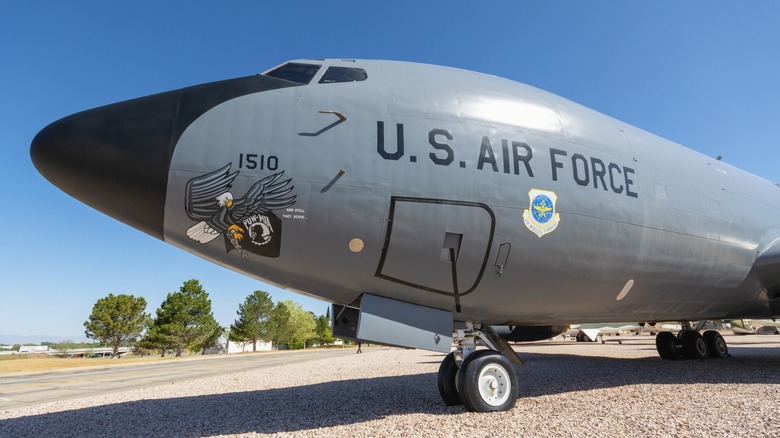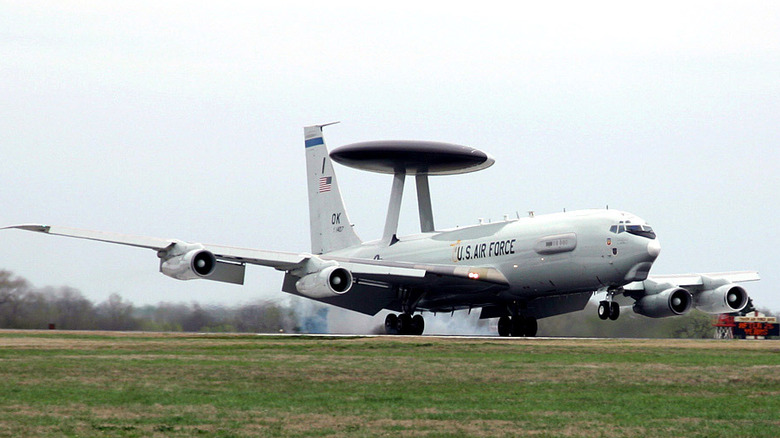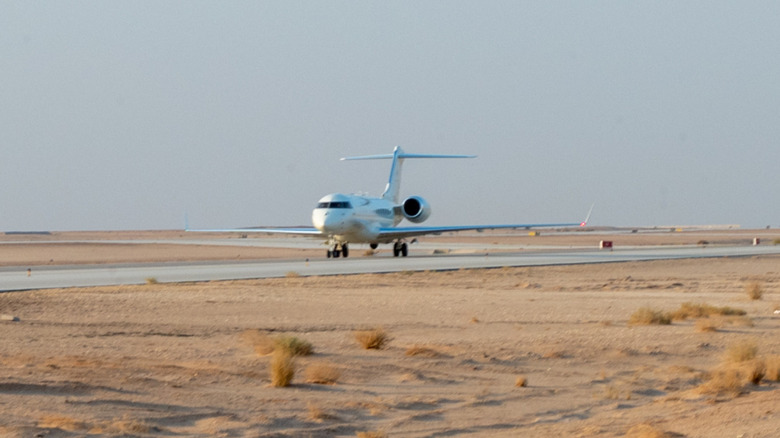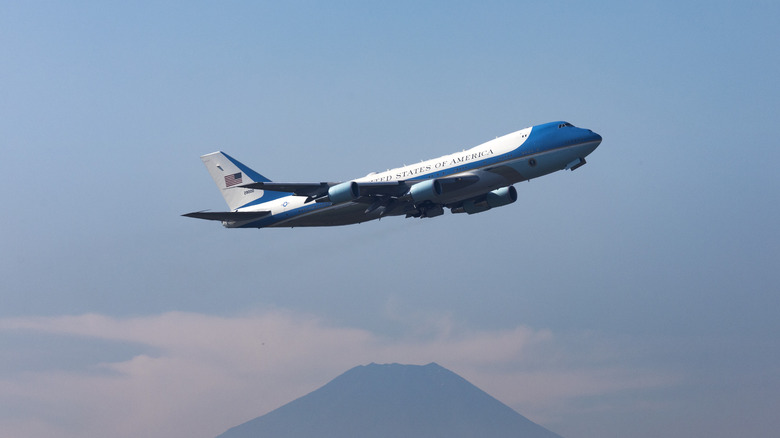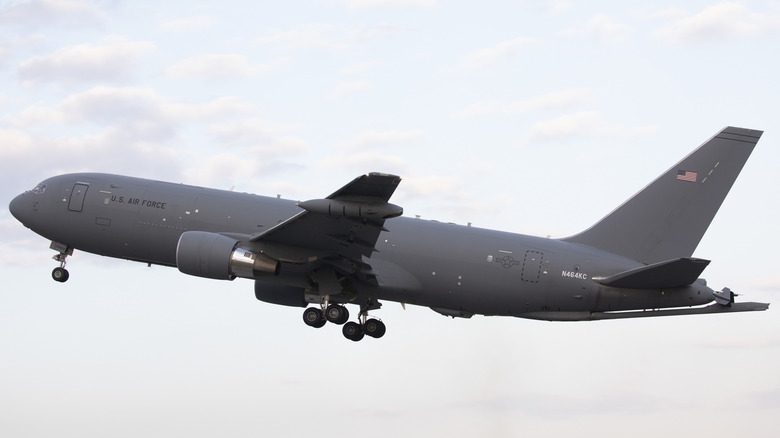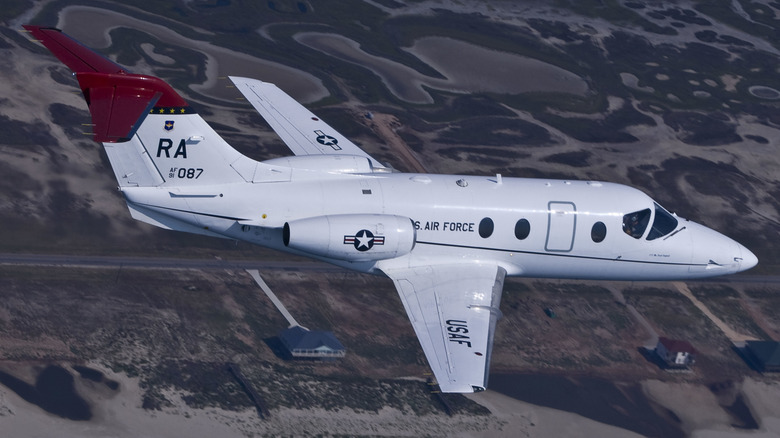5 Civilian Jets Used By The US Military
The U.S. government has been flying military versions of civilian aircraft since the early days of aviation. The Ford Trimotor, made between 1926 and 1933, also came in an Army Air Corps version called the C4-A. The Boeing 247 was used as a military transport aircraft, too.
During World War II, the use cases for civilian aircraft grew. Douglas' DC-3 became the C-47 and saw action in roles ranging from paratroop transport and glider tug to cargo hauler. The Piper J-3 Cub, first built in 1938, was used for everything from air ambulance to observation to transport.
The jet age came to the newly minted U.S. Air Force piecemeal. Pre-production fighter jets were stationed in Italy as early as 1945. Bombers appeared in 1947 with the B-45 Tornado. Cargo aircraft still had propellers, however, until Boeing introduced a testbed called the Model 367-80 in 1954. This aircraft was the background for both an airframe that would encompass the KC-135 Stratotanker tanker and a similar commercial jetliner of different dimensions the world would know as the 707.
Boeing 707
The Boeing 707 was not the first or even the second jetliner in the air – those honors belong to the De Havilland Comet in the UK and Tupolev Tu series in the USSR. What makes the 707 different is that it saw mass adoption worldwide. The USAF also found the airframe useful and had Boeing modify them for specialized purposes. The most striking 707 variant still in use is the E-3 Sentry. By the mid-1960s, the USAF needed to replace the propeller-driven EC-121 Warning Star for early warning and command duties. The resulting E-3, with its distinctive flat radar dome on top, has been in service since 1975.
Along with the Sentry, there are various command and control aircraft under the E-6 Mercury and E-8 Joint Stars designations. In particular, the U.S. Navy operates the E-6B as an airborne command post to maintain a connection with its nuclear submarine force. The U.S. Air Force likewise uses the E-8C for command and control with land forces.
The most famous use of 707 variants fall under the VC-137 nomenclature. This includes transports such as the retired SAM-26000 and SAM-27000 presidential transports, which were formally called Air Force One only when the president was flying on board.
Bombardier Global Express 6000
The Bombardier Global Express has been modified for several military roles. Militaries worldwide use it for everything from VIP transport to early warning to maritime patrol. In the U.S. Air Force, the Global Express is known under the E-11 designation, and it replaces some functions of the E-8. The E-11 is an airborne Battlefield Airborne Communications Node, or BACN, originally developed for operations in Afghanistan.
More than just a flying router, the BACN enables communication between normally incompatible systems throughout a theater. Such nodes make it possible for information to get where it needs to go on the battlefield, even beyond line of sight. The E-11A saw use in Southwest Asia in the 2010s and is now used in the Middle East to deliver humanitarian aid to Gaza. Deliveries of the E-11 are continuing, and the U.S. Air Force expects to field them by 2027. In 2024, Bombardier won a contract to provide a Global Express 6500 for signals intelligence with an option to buy two more.
Boeing 747
The Queen of the Skies, as the 747 series was called, spawned relatively few variants used by the U.S. military. The U.S. Air Force flew one, called the YAL-1, as a testbed for lasers capable of shooting ballistic missiles out of the sky. There are also four recently updated E-4B Nightwatch serving as National Emergency Airborne Command Post (NEACP) aircraft. The E-4B are based on the 747-200 and are slated to be replaced by second-hand 747-8s purchased from Korean Air Lines.
The most famous use of the 747, though, is as the presidential transport VC-25, tail codes 28000 and 29000. The VC-25s are also modified 747-200s, and they were delivered during the presidency of George H.W. Bush. The VC-25B, based on the 747-8, is slated to replace the older version, but substantial funding and delays have been scrutinized. Boeing states that the VC-25B would fly further, faster, and with up to 154,000 lb more take-off weight.
Boeing 767
The 767 is a refueling aircraft in USAF uniform. In the 2010s, the KC-46A Pegasus began replacing the KC-135 Stratotanker, which was the other original development direction of the Boeing 367-80 — the base design for the iconic Boeing 707 passenger jet. Awarding the contract had been drawn out over 15 years as vague parameters, political wrangling, and legal issues reset the procurement procedure several times and a name change from KC-767.
The KC-46A experienced some teething pains and was grounded in 2019. Since then, though, the aircraft participated in Project Magellan, which included a 45-hour non-stop flight around the world. During the flight, the KC-46 both fueled other aircraft and was refueled as well.
While classified as a tanker, the KC-46 can transport passengers as well as cargo. The floor accepts pallets for both passengers and cargo. Its maximum cargo capacity is 65,000 pounds, and it can carry up to 58 passengers. The KC-10 Extender, in comparison, can hold 75 passengers and nearly 170,000 pounds of equipment.
Beechjet 400A
Both the U.S. Navy and Air Force have used the Raytheon T-1A Jayhawk as an advanced trainer. While the aircraft is essentially the same as the Beechjet 400 commercial aircraft from the 1990s, it spends more time landing and taking off with student pilots — so the Jayhawk has an extra fuel tank and bird strike protection. The U.S. Air Force has been flying the Jayhawk since 1992. Pilots who learn on this platform move on to transport aircraft or tankers and fly the T-38 Talon for their advanced training.
While the Jayhawk has been out of production for many years, the 178 aircraft of the type have been modernized, but the Air Force expects to phase out the T-1A. The Beechjet 400 that it is based on is similarly long-lived. Nextant Aerospace has been selling an extensively overhauled version that legally counts as a new aircraft despite the old airframe.
